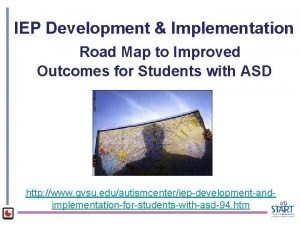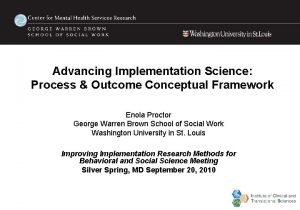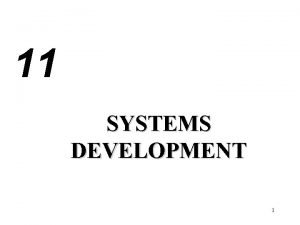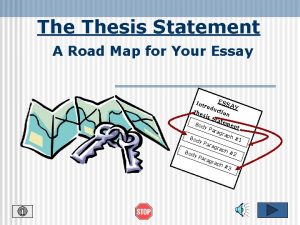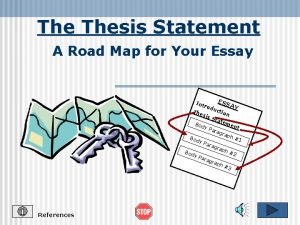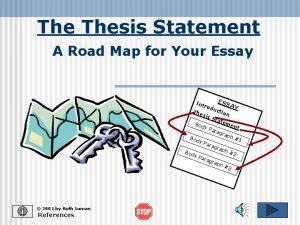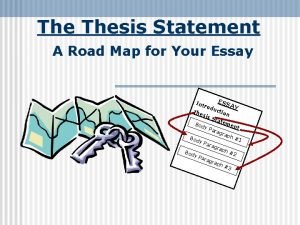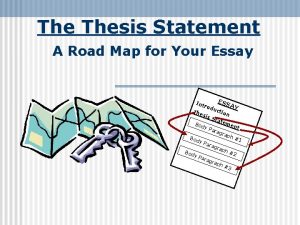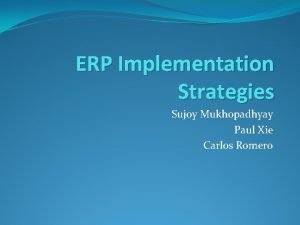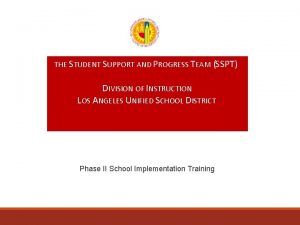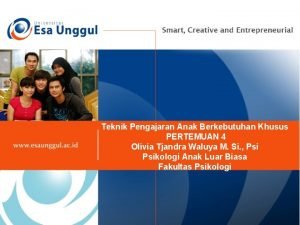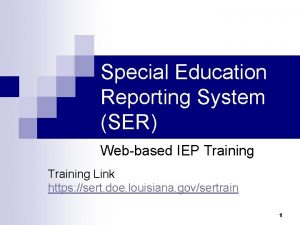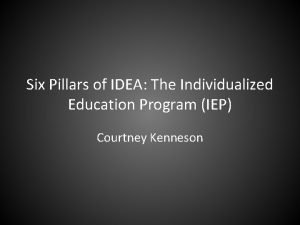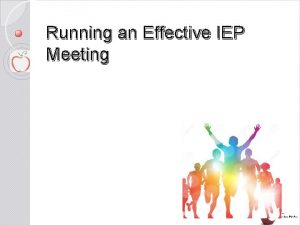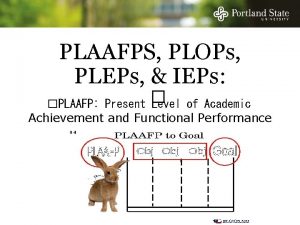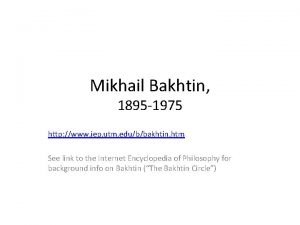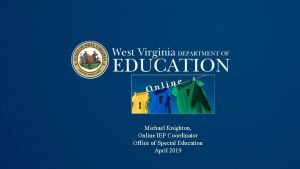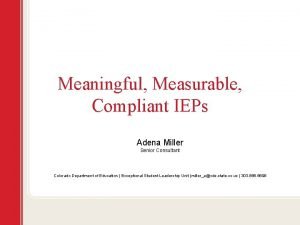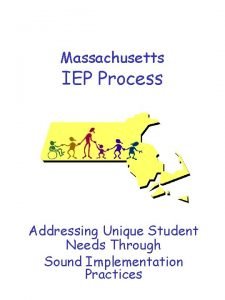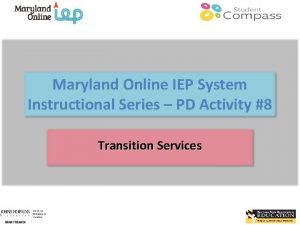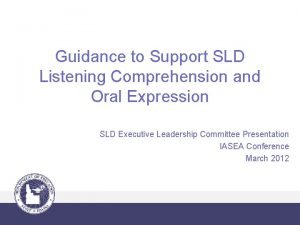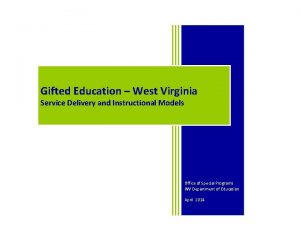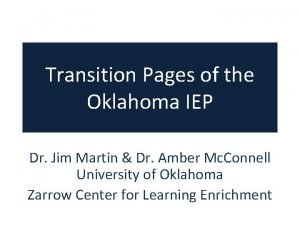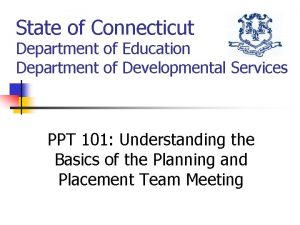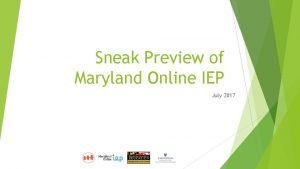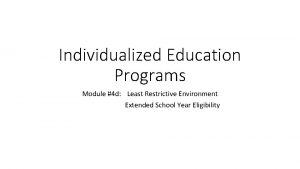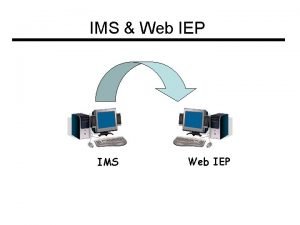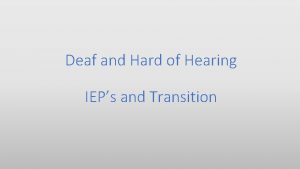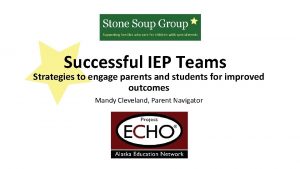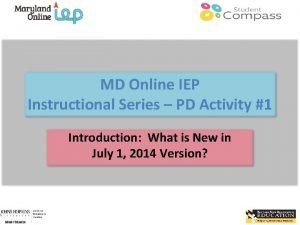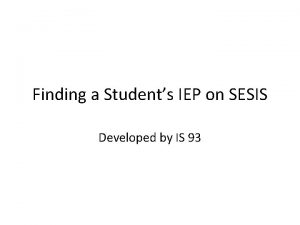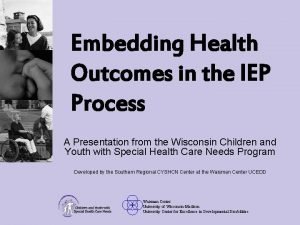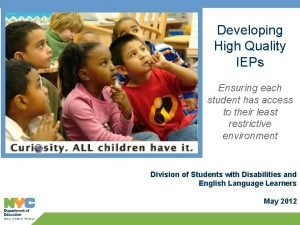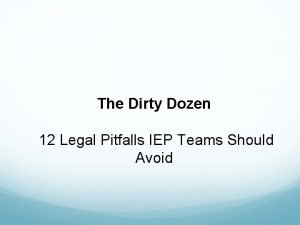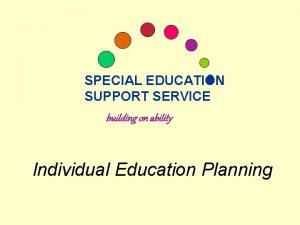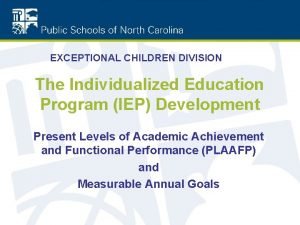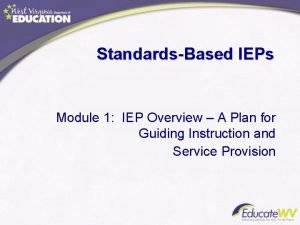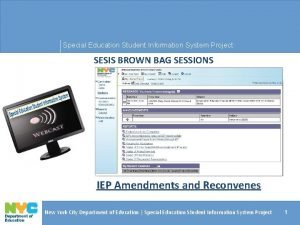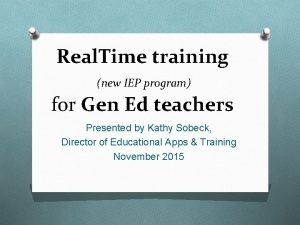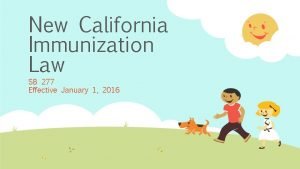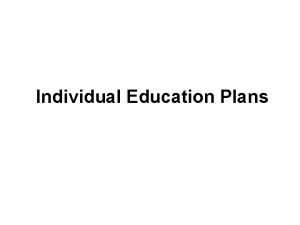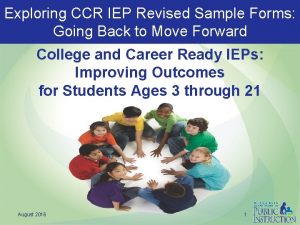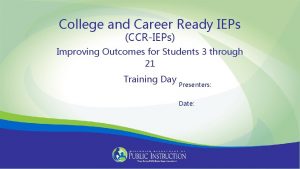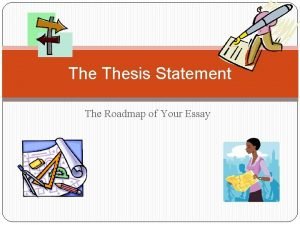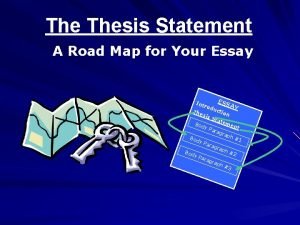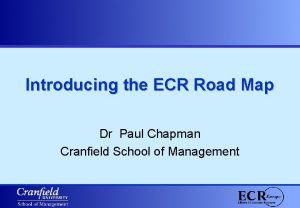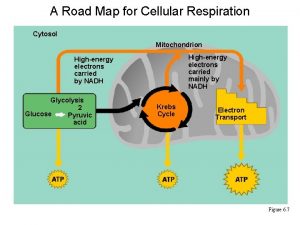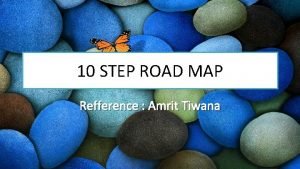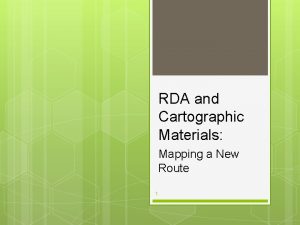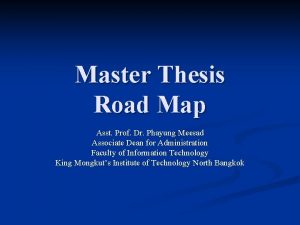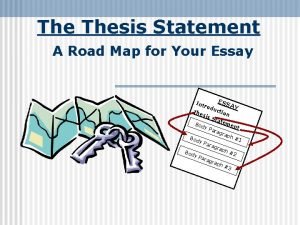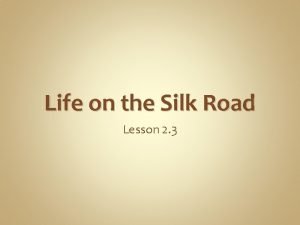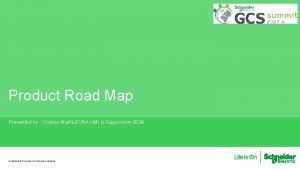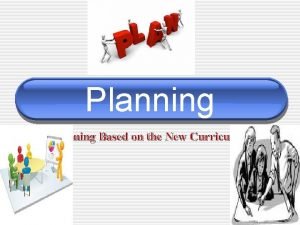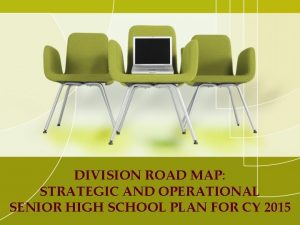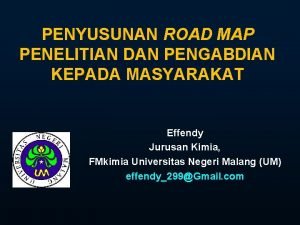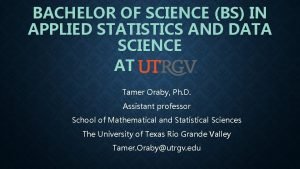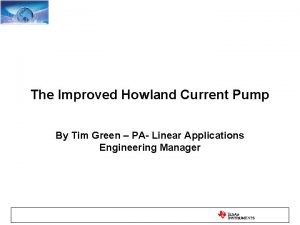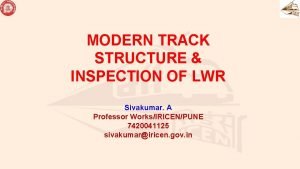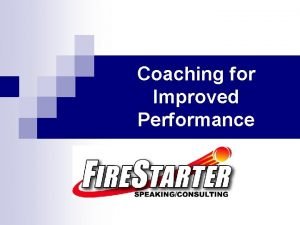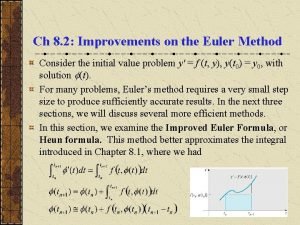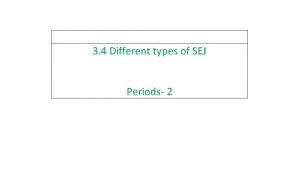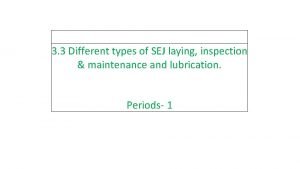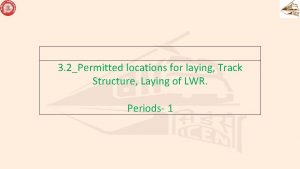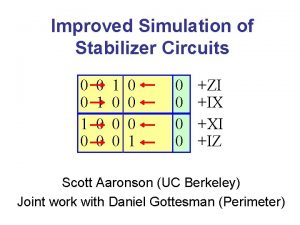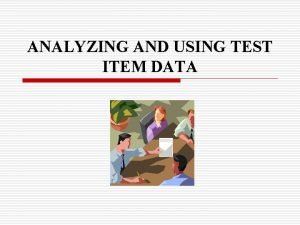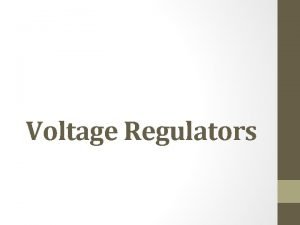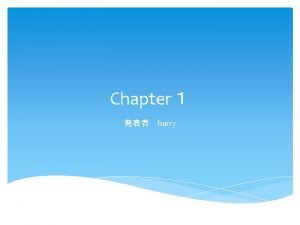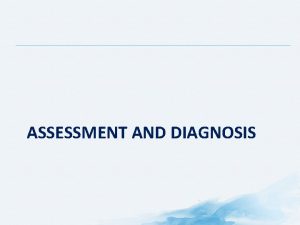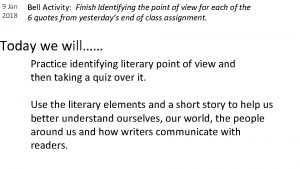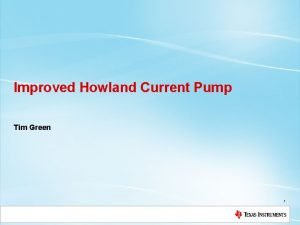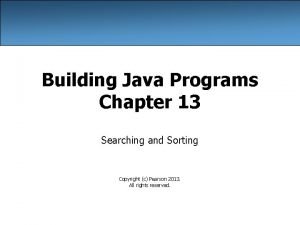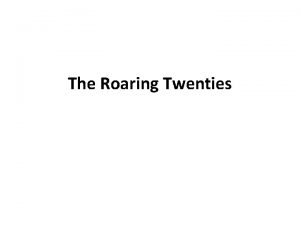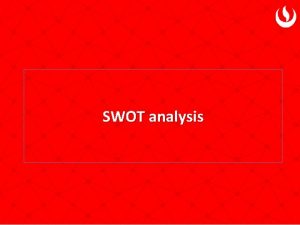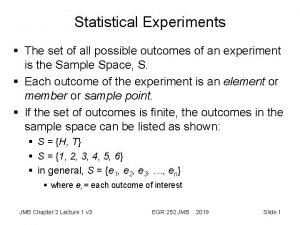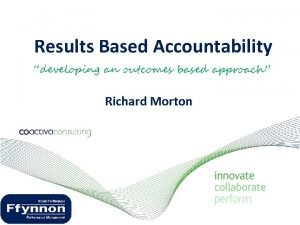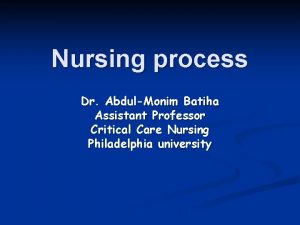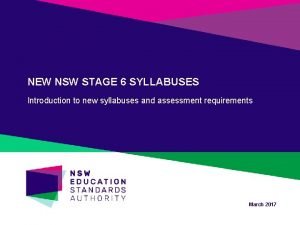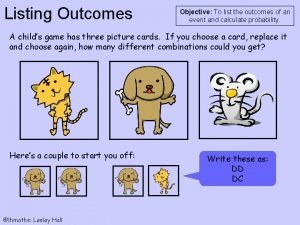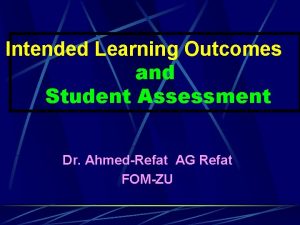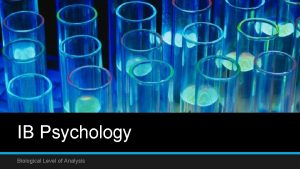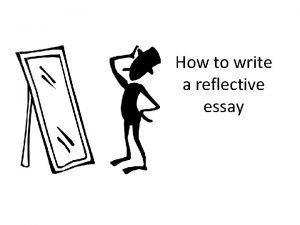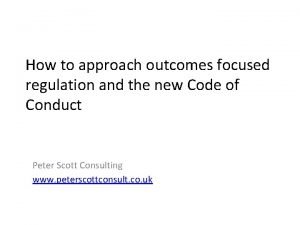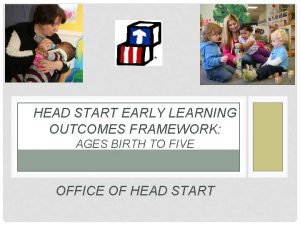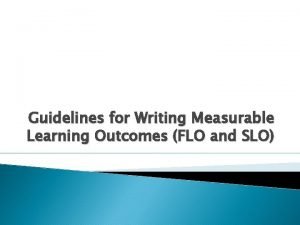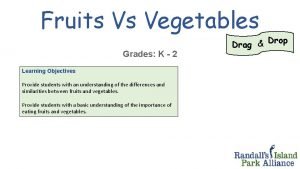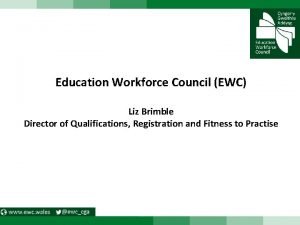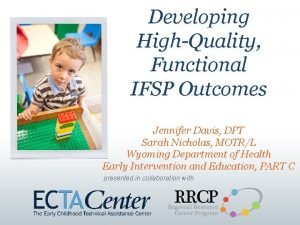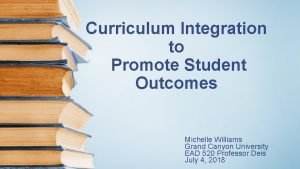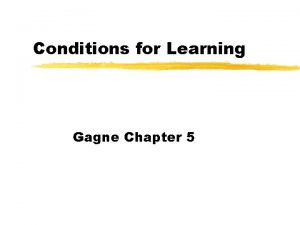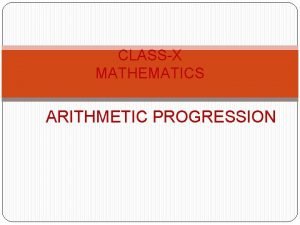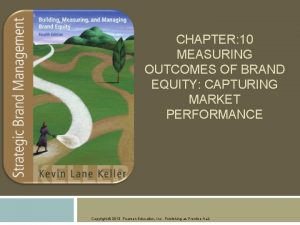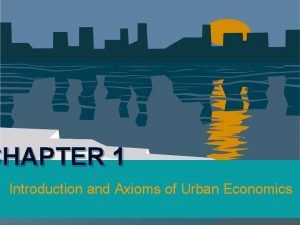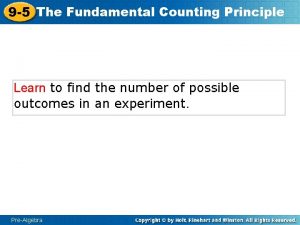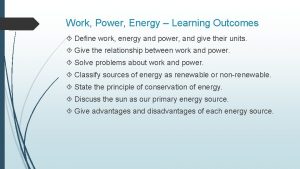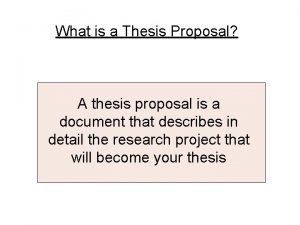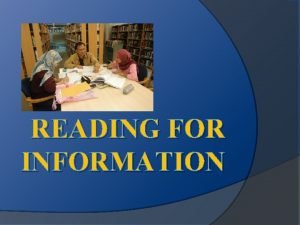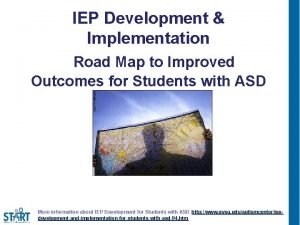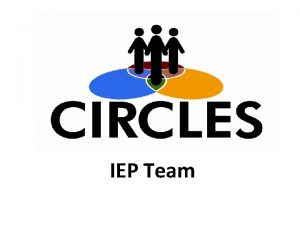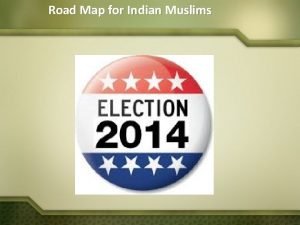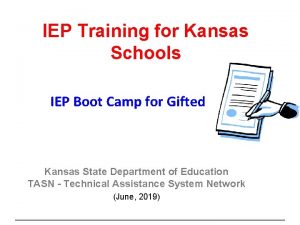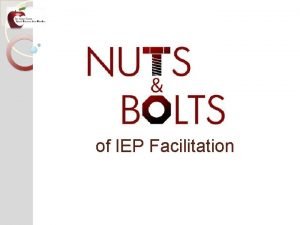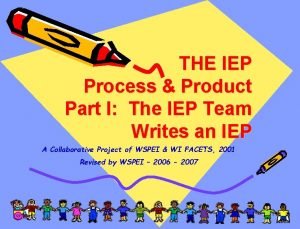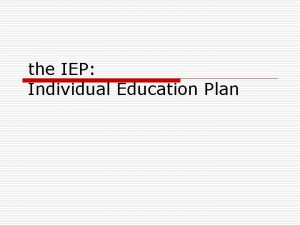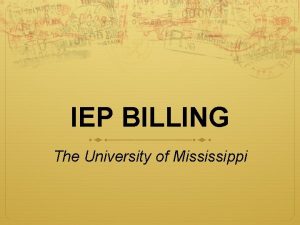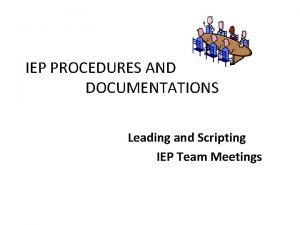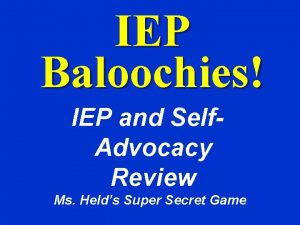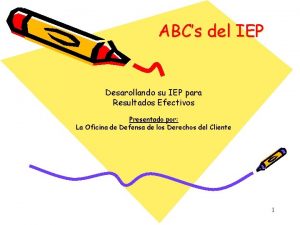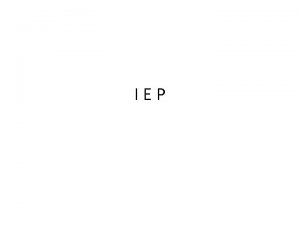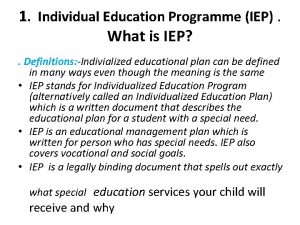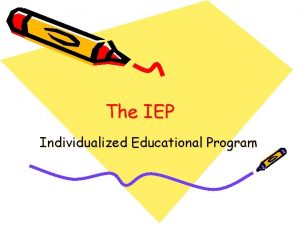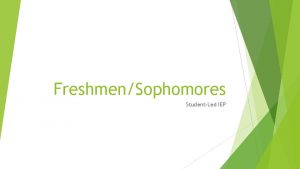IEP Development Implementation Road Map to Improved Outcomes






















































































































































- Slides: 150

IEP Development & Implementation Road Map to Improved Outcomes for Students with ASD IEP Development and Implementation for Students with ASD

INTRODUCTIONS Learning Principles Talk during Team Time (no sidebars) Technology Use Q & A Procedures

Your Learning Accountability • NOVICE • INTERMEDIATE • ADVANCED

History Lesson: IEP Module • Purpose of Tools (POC) • Implementation the follow up year • Errors in the IEP Process

Errors in the IEP Process • PLAAFP • Goals and Objectives not related to ASD • Laundry list of SAS • Standard Time for Service • Placement decisions predetermined – Lack of LRE in the Process

Purpose of this Module NOT Compliance Training in IEP Development “Results will no longer take a back seat to compliance. ” Eleanor White, Michigan State Director of Special Education

Purpose of this Module • IS NOT – – • IS – – Compliance training in IEP development Cover ALL aspects of IEP development Address issues related to ALL disabilities An IEP; Considered Pre-IEP Planning Focus on PROCESS not FORMS Consider LRE throughout the process Address the unique needs of students with ASD Improve IEP Implementation • “IEP Implementation CONTINUES to be the most frequent state (MDE) complaint…” 2012 OSE Update http: //www. michigan. gov/documents/mde/2013_OSE_Update_430438_7. pdf

Materials for Today • 3 years of IEPs for target student (current and 2 years prior) • Most recent REED (Review of Existing Evaluation Data) • Most recent MET report • Progress reports, grades, report cards, etc. • Curriculum for target student’s grade level: – GLCEs (GLCEs) – MMC (Michigan Merit Curriculum/ Graduation Requirements ) – CCSS (Read the Standards ) • Data report for SPP #5: Education Environments: Education Report

IEP Module AGENDA • Understanding Special Education – – History of Special Education Vocabulary Lesson Purpose of the IEP Ed Benefit Review • Developing the IEP – – The PLAAFP Supplementary Aids / Services / Personnel Supports Goals and Objectives S. E. Programs/Services and Ancillary/Related Services • IEP Implementation – Implementation Fidelity – Measuring Progress

COMMON LANGUAGE ACTIVITY IEP Module Activity Packet • Define / Describe FAPE • Define / Describe LRE • What is the purpose of an IEP? • Describe Special Education

OUR DECISIONS HAVE TO ALIGN WITH: • THE LAW • THE RESEARCH • THE DATA

WARNING • I heard that…. • I was told…. PRACTICE IS NOT NECESSARILY LAW, POLICY, or RULE Story of the Ham

History of Education • Horace Mann: – Father of American Education • Common Schools / Teach Common Values – EQUALITY • Compulsory Education – Tax $$$

SPECIAL EDUCATION HISTORY • 1954 Brown vs. Board of Education – Schools inherently unequal – “…… human tendencies to prejudge, discriminate against, and stereotype other people by their ethnic, religious, physical, or cultural characteristics…. . ”

Impact of the Brown Decision • Elementary and Secondary Education Act of 1965 (underprivileged students) • PARC and MILLS: Exclusion of students with disabilities • Congressional Investigation 1972 of education of children with disabilities – Millions not served • 1975: Congress enacted P. L. 94 -142 – Children with disabilities have a RIGHT to education – Ensure ACCESS to education Wright & Wright, 2009

Individuals with Disabilities Education Act (IDEA) IDEA • FAPE • LRE

FAPE Is an Equitable Education

What is FAPE? IDEA Special Education & Related Services = Specially Designed Instruction Adapting the content, methodology or delivery of instruction – To address unique needs resulting from the disability – To ensures access to the general curriculum to meet the educational standards that apply to all children in the state U. S. Supreme Court Interpretations: • Board of Education of Hendrick-Hudson Central School District v. Rowley, 458 U. S. 176 (1982): “Reasonably calculated to achieve EDUCATIONAL BENEFITS. ” • Endrew F. v. Douglas County School District Re-1, 137 S. Ct. 988 (2017): “Reasonably calculated to make progress appropriate in light of circumstances…. to meet challenging objectives. ” Appropriately Ambitious

What is FAPE? • Larger implications of ADA • USDOE has recently released two technical assistance documents on how IEP Teams should operationalize FAPE. • 11 -16 -15 Dear Colleague Letter –access to age level curriculum • 12 -7 -17 Q&A on Endrew

What is FAPE? IDEA 2004 To provide FAPE, schools must provide students with an education that prepares the child for further education, employment, and independent living. 20 U. S. C. § 1400(c)(5)(A)(i)

ASD and Employment Reference Statistic ARC-FINDS Survey (2010) The Arc 85% unemployment, intellectual and developmental disabilities Autism Society of America 83% unemployment, ASD Facts and Statistics Autism Speaks 85% unemployment, ASD American Graduate (video-3: 55) 68% unemployment, any disability

Employment Outcomes http: //drexel. edu/autismoutcomes/publications-and-reports/publications/Employment. Outcomes-of-Young-Adults-on-the-Autism-Spectrum/#sthash. OQiyp. R 7 u. dpbs 2015 National Longitudinal Transition Study 2

What predicts post-school employment? • Students who had the highest degree of integration with age-appropriate peers were more likely to engage in post-school employment • IQ, behavior problems, physical disability, and individual demographics did not correlate with integrated employment outcome White, J. & Weiner, J. S. (2004). Influence of least restrictive environment and community based training on integrated employment outcomes for transitioning students with severe disabilities. Journal of Vocational Rehabilitation, 21, 149– 156.

Predictors / Outcomes Education Employment Indep. Living Career Awareness P (Potential) P -------- Community Experience -------- P -------- Exit Exam Requirements / High School Diploma Status -------- P -------- Inclusion in General Education M (Moderate) M M Interagency Collaboration P P -------- Occupational Courses P P -------- Paid Employment / Work Experience M M P Parental Involvement --------------- Program of Study -------- P -------- Self Advocacy / Self Determination P P -------- Self Care / Independent Living P P M Social Skills P P -------- Student Support P P P Transition Program M P -------- Vocational Education M M -------- Work Study -------- M -------- National Secondary Transition Technical Assistance Center (NSTTAC)

Individuals with Disabilities Education Act (IDEA) IDEA • FAPE • LRE

LEAST RESTRICTIVE ENVIRONMENT “To the maximum extent appropriate, children with disabilities…. are educated in the general education classroom with children who are not disabled…” …. and that special classes, separate schooling, or other removal of children with disabilities from regular education environment occurs only if the nature or severity of the disability is such that education in regular classes with the use of supplementary aides and services cannot be achieved satisfactorily. ” 34 C. F. R.

Current Theme in Inclusive Education Outcome Research Students with Extensive Support Needs Intellectual Disabilities Autism Spectrum Disorder Multiple Disabilities

Kurth & Mastergeorge, 2010 • 15 Ss w/ ASD (not AS) – 12 males • 7 -9 th grade; 12 -15 years old • 7 spent >80% day in Gen. Ed; math and reading instruction in Gen. Ed • 8 self-contained spent >50% in Sp. Ed; math and reading instruction in Sp. Ed • Measures: – Cognitive Gen. Ed mean 64. 9; Sp. Ed mean 60. 0 – Adaptive Gen. Ed mean 44. 4; Sp. Ed mean 42. 3 – Academic—WJ 3 • Broad Reading: Gen. Ed mean 67. 6; Sp. Ed mean 13. 1 • Broad Writing: Gen. Ed mean 83. 6; Sp. Ed mean 14. 1 • Broad Math: Gen. Ed mean 77. 4; Sp. Ed mean 8. 5 Academic and Cognitive Profiles of Student with Autism: Implications for Classroom Practice and Placement. International Journal of Special Education, 25 (2), 8 -14.

“There is clear and convincing evidence that inclusive educational settings can confer substantial short and long-term benefits to students with and without disabilities. ” Students with Disabilities • Increased academic achievement & graduation • Increased independence • Increased engagement • Increased attendance • Increased communication skills • Increased social competence & quality of relationships • Decreased behavior / disciplinary referrals Students without Disabilities • Same level of teacher attention • Neutral or Positive Effects – Academic Achievement – Social Competence • Additional Benefits: – Reduced fear of human differences – Increase friendly relationship – Less prejudice – Less patronizing / pitying behavior Quirk, C. , Ryndak, D. L. , Taub, D. (2017) Research and Evidence-based Practices to Promote Membership and Learning in General Education for Students with Extensive Support Needs. Inclusion, 5 (2), 94 -109.

There is STRONG Evidence that Student with “Extensive Support Needs” – Acquire skills and content knowledge (including literacy) in general education with rigorous instruction and UDL-based adaptations (e. g. differentiated instruction; universal supports, literacy supports (Kluth)) – Are BEST served by educational teams that approach their education with the intent of finding solutions to access and learning barriers rather than alternative placements. Involvement and Progress in the General Education Curriculum for Students With Extensive Support Needs: K-12 Inclusive-Education Research and Implications for the Future. Ryndak, Lewis & White, (2013).

What is SPECIAL EDUCATION? --NOT a place --IS a set of supports and services to ensure ACCESS & PROGRESS in GENERAL EDUCATION WHERE the child receives special education services is the PLACEMENT…. The first “where” to consider is…

Purpose of the IEP Define Special Education necessary to assure FAPE in the LRE: Access to, participation and progress in…. General Education Curriculum

P t ODE en atem 0 St 80/8 Continuum of Services MI Thresholds for Restriction SPP Indicator 5: Educational Environments Current Targets B-5 educational Environments

“Inclusion Confusion” Geography is a necessary but insufficient variable for providing an inclusive education. Content of Instructional Strategies Intensity of Instruction Opportunity to Respond Culture of Belonging Environmental Supports Quirk, C. , Ryndak, D. L. , Taub, D. (2017) Research and Evidence-based Practices to Promote Membership and Learning in General Education for Students with Extensive Support Needs. Inclusion, 5 (2), 94 -109.

Inclusion as an Equitable Education Equal Opportunity • Full membership in the social and learning contexts • Intentional development of supports to address learning, social, and behavioral needs to ensure access and progress in the general education curriculum and in pivotal (engagement / independence) & functional / adaptive skills and IEP goals.

District / ISD data report for SPP #5: Education Environments: School Data

DISCUSSION

Why do we continue to perpetuate a segregated culture? DISCUSSION

Incremental Steps YOUR ACCOUNTABILITY Your Behavior Expresses Your Belief System

Your Behavior Expresses your Belief System… DO YOU…… • Send a folder of “alternative” work with the student to the general education class? – Have “token” LRE time? Specials only? • Have all the special education students eat at one lunch table? Have a different recess? • Use of activities that are inappropriate for the age of the student (ex. Calendar / Clifford). – Exposure Breeds Preference!! • Talk about students with ASD in front of them?

Your Behavior Expresses your Belief System. DO YOU. . . • Use disability-first language? – Use “high functioning” and “low functioning” to describe students? – Talk about students based on their eligibility category rather than their name? (The Autistics) • Blame the STUDENT? – Not motivated; Not ready; Unemployable; OTHERS? • Adopt a “protective” attitude? – DIGNITY OF RISK!! • Talk about the student’s lack of perceived competency rather than their contributions? – LEAST DANGEROUS ASSUMPTION

Self Evaluation IEP Module Activity Packet Beliefs and Behaviors that PREVENT Integrated Opportunities

You did what you did when you knew what you knew…. . You now know different – which makes you accountable!!

Self Evaluation IEP Module Activity Packet Your Accountability to the Change Process Beliefs and Behaviors that SUPPORT Integrated Opportunities

Making Change Happen • If you write it down, you are more likely to do it…. AND…. • If you TELL someone else, you are even MORE likely to do it…. AND…. • If you post it, you are that much MORE likely to do it! !

Educational Benefit Review PROCESS • Was the IEP reasonably calculated to ensure Educational Benefit? • What IS Educational Benefit? – Rowley (Supreme Court 1982)--more than minimal progress – Rowley in 2007 (aligned with IDEA 2004 / NCLB and Endrew) • • • PLAAFP related to involvement / progress in general curriculum MEASURABLE “appropriately ambitious” annual goals Services planned to support PROGRESS toward goals In the LRE (gen ed curriculum / environment) IEP adjusted if no progress made

Materials Needed • Handout in your packet • 3 years of IEPs (current year is year 1) • Most recent MET / other assessments • Most recent REED (Review of Existing Evaluation Data) • Progress Reports on IEP goals

Step 1: Complete ONE for Each Year What needs are listed in the PLAAFP? What are the supplementary aids and services? List the goals and objectives / benchmarks? What are the programs and services. What evidence of progress is available? Did the student make adequate progress?

Step 2: Analyze the Relationship Among Components Are the needs in the PLAAFP the PRIMARY ones related to the disability and access and progress in the general education CURRICULUM and ENVIRONMENTS compared to peers? Where is each need addressed in the IEP? Does EACH supplementary aid and service address a need(s) specifically listed in the PLAAFP? Are Universal Supports for students with ASD considered / addressed? Does each goal specifically address a need(s) listed in the PLAAFP? Are the goals and objectives/ benchmarks measurable? For each goal and objective/ benchmark, is there a program or service to address it? Are the programs and services designed to ensure progress on the goals and objectives / benchmarks? How did the IEP team consider LRE in the development of the programs / services? Is there objective data (i. e. direct assessment or observation) to support progress on the goals and objectives? Did the student meet the goals? If not, was the IEP re-designed to address it?


Identify the HOLES

Step 3: Analyze Relationships ACROSS Years Ed Benefit?

By End of Today • 3 years of IEPs analyzed by year • 3 IEPs analyzed across 3 years • Questions considered / answered • Determine Ed Benefit

REPORT OUT Ed Benefit?

An IEP Process that…. . • Focuses on PROCESS not FORMS • Considers LRE throughout the process • Addresses the unique needs of students with ASD • Improves IEP Implementation

An IEP using Meeting Mechanics • • • Visual Support (white / chart board) Facilitator Note-Taker (IEP Form / Computer) Process (Logical IEP Progression) Brainstorming Principles – – Democratic All ideas are considered / recognized Professional Role Elimination OTHERS (FRONTLOAD) • Decision-Making Rules – No opinion unless informed by: • Law; Research; Data

IEP Process Tools


White Board IEP 3 Benefits & 1 Challenge

Fatal Comments during the IEP • • “We can’t do that!” “We don’t…” “That would cost too much. ” “No student receives more than ____ minutes of service per week. ” • “We don’t have staff to…. ” • “I’m only in the building one day a week” Thrun Law Firm, P. C. & Scholten Fant, 2007

Fatal Communication Error • Lack of succinct, clear responses: Comes across like dodging answers: – “Well, it depends…” – “Well, it might, could, should, etc…. ” – “It varies…” – “Well, I’ve only seen him 3 x…”

Sentence Starters…. . • “The data suggests…. ” • “We have evidence that shows…. ” • “Our observations have shown…” • “The law indicates…. ” • “The research supports…. ”

IEP Guiding Principles: Avoid Human Nature Traps!! • All opinions informed by the law, research, & data. • We cannot change the past; We can change today to establish a different future. • Communication requires interpretation: What is said may not be what was meant. • Presume Competence (Least Dangerous Assumption) • Dignity of Risk

Pay Attention to the Signs (Facilitating Peace in the IEP Process, MAASE 2016) Looming Disagreement – – – Challenging questions Request to audiotape meeting Bringing advocate (or others) Prescription for services Outside reports Insistence on particular eligibility – OTHERS? Staff Behaviors that Inhibit Consensus – Lack of data – Inaccurate / unprofessional reports – Sharing misinformation – Unclear explanations – Excessive use of jargon – Inflexible communication (“this is how we do it”) – Demonstrating lack of respect

What to BRING to the IEP • DATA: Not PLAAFP already written – Assessment Information – Observational Data – Background Knowledge • Considerations for Supp Aids and Services • Goals and Objectives / Benchmarks IDEAS NOT: “My PLAFFP” / “My GOALS”


The Schedule Matrix for PLAFFP Development

Schedule Matrix Examples

Schedule Matrix Examples

Data to Support Impact and Need ENGAGEMENT

Data to Support Impact and Need INDEPENDENCE

Data to Support Impact and Need SOCIAL Early Childhood Elementary Secondary

The IEP


The PLAAFP


Elicit Parent Input Guiding Principles

Passport

PLAAFP Statement MDE Model Form ONE of 3 Options • Option I: Identification of need across a number of specified areas • Option II: Narrative Approach • Option III: Designed for use with progress monitoring systems

The PLAAFP Statement of the student’s Present Levels of Academic Achievement and Functional Performance (and transition related needs). Question you are attempting to answer: How does the student’s DISABILITY impact access to and participation in & progress in: • The general education CURRICULUM • General education ENVIRONMENTS (including social skill development, independent skills, etc. )? • Further education, employment, and independent living

What about “ACADEMIC ACHIEVEMENT? ” • ED did not define “academic achievement” • 2006 IDEA Regulations: – “’Academic achievement’ generally refers to a child’s performance in academic areas (e. g. reading, math, science. . ). We believe the definition could vary depending on a child’s circumstance or situation, and therefore, we do not believe a definition of ‘academic achievement’ should be included in these regulations. ” • ASD Eligibility Requirements….

PLAAFP Statement Framework AREAS of the student’s DISABILITY that impact access to and participation & progress in: • The general education CURRICULUM • General education ENVIRONMENTS (including social skill development, independent skills, etc. )? • Ability to Participate in Instruction • Socialization Skills / Competence • Communication • Independent Skills • Transition Issues • Ability to Manage Stress / Anxiety • Behaviors Janzen, J. , 2003

PLAAFP Statement Framework AREAS of the student’s DISABILITY that impact access to and participation in & progress in: The general education CURRICULUM General education ENVIRONMENTS (including social skill development, independent skills, etc. )? • Ability to Participate in Instruction • Socialization Skills / Competence • Communication • Independent Skills • Transition Issues • Ability to Manage Stress / Anxiety • Behaviors DATA for each area— COMPARED TO SAME AGE PEERS

OPTIONS for DATA • • • Standardized Measures Rating Scales State / Local Assessments Behavior Plans / Logs Classroom Output Grades / Progress on Current IEP Goals Direct Observation GLCEs MDE Quick Reference Guide: Section 2 PLAAFP

Make sure data is ACCURATE

PLAAFP Statement Framework AREAS of the student’s DISABILITY that impact access to and participation & progress in: The general education CURRICULUM General education ENVIRONMENTS (including social skill development, independent skills, etc. )? • Ability to Participate in Instruction • Socialization Skills / Competence • Communication • Independent Skills • Transition Issues • Ability to Manage Stress / Anxiety • Behaviors How do these needs IMPACT access to, Data for involvement & EACH area— participation in, success in general COMPARED TO education PEERS CURRICULUM and ENVIRONMENTS?

PLAAFP Statement Guided Practice Area Social Data IMPACT Sean has 97% fewer social In the classroom, Sean does not interactions than others students choose a partner or join a work the same age based on staff group without adult prompting. He observations. He talks about Star does not participate in cooperative Wars excessively which results in work with peers without peers resisting interaction with him. argument, which results in adult He does not have a preferred friend, intervention and 3 -4 times per and at lunch and recess, he plays week, Sean having to leave the alone. According to the classroom due to disruption. Social “developmental inventory”, typical interactions are impacted by peers can identify a preferred friend continual Star Wars talk. and interact with others during play activities.

PLAAFP Statement Guided Practice Area Independent Skills Data IMPACT Sean does not independently navigate the daily schedule. He Because Sean requires intensive requires 6 -7 verbal and visual adult prompting to follow the daily prompts by adults before routine, prepare for classroom following simple tasks. He does activities, and complete classroom not independently get materials work, he misses instruction as much he needs to complete classroom as 40 minutes per hour. As such, he activities and tasks, and requires is pulled out of the classroom to constant adult prompts to “catch up” on his work as much as complete classroom work. an hour a day at which time he is Based on classroom missing the other instruction in the observations, typical peers classroom. navigate the environment independently and complete their assignments with minimal adult prompting / support.

PLAAFP Statement EXAMPLE Area Behavior Data IMPACT Sean has a low frustration Based on teacher report and tolerance especially with classroom observations, when paper / pencil academic frustrated, Sean misses as tasks. When this occurs, much as 20 -30 minutes per which ranges from 3 -5 times incident of engaged time per day, he whines and will attempting to deal with his not continue his work. frustration. Additionally, he When extremely frustrated does not utilize strategies for which occurs 2 -3 times reducing his frustration so he is weekly, he utters swear not able to persist in academic words loud enough for peers tasks which further impacts his to hear him. Based on progress. “developmental inventory”, ‘peers his age persist when frustrated and can identify and use 2 -3 strategies for reducing frustration.

Team Time: Complete PLAAFP Worksheet

REPORT OUT

• Just because there is a NEED does not mean you need a GOAL— • However, you MUST address each need identified in the PLAAFP in another appropriate section of the IEP…. – Secondary Transition Considerations – Supplementary Aids and Services – Goals and Objectives / Benchmarks

Supplementary Aids and Services

What ARE Supplementary Aids / Services? • § 300. 42 Supplementary aids and services means aids, services, and other supports that are provided in regular education classes, other education-related settings, and in extracurricular and nonacademic settings, to enable children with disabilities to be educated with nondisabled children to the maximum extent appropriate in accordance with §§ 300. 114 through 300. 116. (Authority: 20 U. S. C. 1401(33))

MDE Interpretation of the Purpose of Supplementary Aids and Services • Provided to enable the student to: – Advance appropriately toward attaining the annual IEP goals. – Be involved and progress in the general education curriculum and to participate in extra-curricular and other nonacademic activities. – Be educated and participate in activities with other students with disabilities and nondisabled students. MDE OSE-EIS Quick Reference Guide: Section 5

Supplementary Aids / Services Universal Supports (the Non-Negotiables) • Visual / Organizational Supports • Functional Communication System • Accommodations / Differentation • Peer to Peer Support • Positive Behavioral Interventions and Supports • Appropriate Adult Support

Translating PROCESS to PAPER Documenting Intensive Individualized Plans • VARIABLES: – Nature of the support varies significantly (day to day, content to content, etc. ) – Support is intensive in nature – Support includes a lot of details

Translating Process to Paper MDE Model IEP Form: Section 5 • Positive Behavior Support PLAN • Individualized Accommodation PLAN • Individualized Differentiated Instruction PLAN • Grading Matrix • Individualized Peer to Peer Support PLAN • OTHERS?

Translating Process to Paper MDE Model IEP Form

TEAM TIME Supplementary Aids and Services Worksheet

Developing GOALS and Objectives / Benchmarks

Annual Goals Measurable annual goals must be designed to… • Meet child’s needs that result from child’s disability to enable the child to be involved in and make progress in the general education curriculum • Not --Restatement of gen ed curriculum --List of EVERYTHING the student is expected to learn

What skills does the student need in order to access / master the content rather than what content the student needs to learn. DISCUSSION

What about IEP’s written for / aligned with the Content Standards? • WHY SB-IEP? – MDE Focus on Results June 09 • Excluded from gen ed curriculum; • Exposed to an alternate curriculum w/ deficit driven instruction (remediation); • Not included in district / statewide assessments – MDE IEP References


What about academic goals? • No hard / fast rules • Things to consider: – Definition of “academic” – 3 tiered system of academic support – Have to know ASD—OUTPUT – Gain Rate vs. Time Spent

Identifying Goal AREAS 1. Needs that CANNOT be met through supplementary aids and services (or secondary transition)… AND / OR 2. Other Prioritized Needs and/or Supports from Supplementary Aids and Services that require “specialized instruction”

“Specially Designed Instruction” IDEA Words and Terms to Know (March 2009) Adapting the content, methodology, or the delivery of instruction to address the unique needs that result from the child's disability…. to ensure that the child has access to the general curriculum…. .

Supplementary Aids / Services Universal Supports (the Non-Negotiables) • Visual / Organizational Supports • Functional Communication System • Accommodations / Differentation • Peer to Peer Support • Positive Behavioral Interventions and Supports • Appropriate Adult Support

TEAM TIME Identify Goal Areas

Writing MEASURABLE Goals and Objectives / Benchmarks

Writing MEASURABLE IEP Goals and Objectives / Benchmarks (PROGRESS MARKERS) 1. Write an annual measurable goal with a number of separate but relevant measurable objectives. --Progress on the objectives would lead to meeting the annual goal. 2. Write an annual measurable goal with a number of timed, measurable benchmarks.

Writing Goals (Objectives / Benchmarks) The IEP Form: ADD: by what date; on what assessment? Does not have line for: Utilizing

Writing Measurable Goals Formula for Success • UTILIZING—Using WHAT tool, support, system, etc. will the student learn to perform the skill? • • • Utilizing a visual schedule Using peers / peer to peer support Using a picture choice board When provided the verbal instruction “……” Using a visual functional communication system Utilizing a routine checklist When given a check schedule card Using a choice differentiation Using a self-management checklist


Resources for EBPs • NPDC (NPDC Homepage ) • National Standards Project (National Autism Center at May Institute ) • AIM (Autism Internet Modules) by OCALI (AIM ) • AFIRM (NPDC) AFIRM Modules • Association for Science in Autism Treatment (ASAT online )

Writing Measurable Goals Formula for Success • UTILIZING—Using WHAT tool, support, system, etc. will the student learn to perform the skill? • UNDER WHAT CONDITION(s)—When, Where with Whom

Writing Measurable Goals Formula for Success • Condition--Under what condition should the skill be demonstrated (e. g. time, place, event)? • • • During transition times During a social conversation During class discussions At lunch time During math, science, etc. During morning / lunch recess During independent work When teacher is giving instruction During morning arrival routines When preparing to go home

Writing Measurable Goals Formula for Success • UTILIZING—Using WHAT tool, support, system, etc. will the student learn to perform the skill? • UNDER WHAT CONDITION(s)—When, Where with Whom • BEHAVIOR—Get some VERBS in your sentence – What competency / skill should change? – OBSERVABLE

BEHAVIOR Begin with the End in Mind • • • • Independently transition from activity to activity Make a choice Complete the activity independently Follow the classroom routine Complete the worksheet independently Raise hand wait to be called on Ask for help Initiate interaction with a peer Follow instructions independently Make and engage in a choice Remain in seat / area Answer content-related questions Request a food item Independently put on / take off

Writing Measurable Goals Formula for Success • UTILIZING—Using WHAT tool, support, system, etc. will the student learn to perform the skill? • UNDER WHAT CONDITION(s)—When, Where with Whom • BEHAVIOR—Get some VERBS in your sentence – What competency / skill should change? – OBSERVABLE • CRITERIA— How MUCH / WELL is considered mastery (use peers for comparison)?

CRITERIA (MASTERY) • • • 4 of 5 trials / opportunities 4 of 5 items / assignments 4 of 5 days 4 of 5 class periods 80% accuracy Increase by 10% 3 times a day On 4 consecutive attempts For 15 minutes at a time Within 5 min For 15 min 4 times weekly

GOALS & OBJECTIVES / BENCHMARKS Guided Practice Chris will raise his hand when he needs assistance or wants to share important information. (90% of time)

GOALS & OBJECTIVES / BENCHMARKS Guided Practice • Utilizing a self-management checklist (STRATEGY) Chris will raise his hand share a key idea (BEHAVIOR) during science and social studies (CONDITION) 4 of 5 opportunities (CRITERIA).

GOALS & OBJECTIVES / BENCHMARKS Guided Practice • Chris will raise his hand when he needs assistance or wants to share important information. (90% of time) • Chris will ask for help and accept teacher response when he doesn’t understand something. (80% of time) • With gestural prompts from peers and adults, Chris will limit conversational ideas appropriate to the setting. (90% of time)

GOALS & OBJECTIVES / BENCHMARKS Guided Practice • Utilizing peer to peer support (STRATEGY) Chris will share an idea in the topic area (BEHAVIOR) During conversations at lunch and recess (CONDITION) 4 of 5 opportunities (CRITERIA)

GOALS & OBJECTIVES / BENCHMARKS Guided Practice • Kayla will use appropriate social greetings upon entering and leaving the classroom with teacher and peers (hi, bye) in 8 out of 10 trial days. • Kayla will expressively identify peers and adults by name in group and play activities with verbal prompting. (4/5 trials) • Kayla will gain the attention of a communicative partner by verbal or nonverbal means to make a request, to gain assistance, and to engage in activities. (4/5 trials)

TEAM TIME Write 3 Measurable Goals

Benchmarking Measurable Goals

Benchmark Example:

Benchmark Example: Level of Attainment Annual Goal : Independently follow a visual schedule 4 of 5 days. 0 Given a visual “check schedule” card and the verbal instruction “check your schedule, ” with 5 -8 verbal / physical prompts, Ss will select each activity from the visual schedule and transition to the appropriate area for that activity on 2 of 5 days. +1 Given a visual “check schedule” card and the verbal instruction “check your schedule, ” with no more than 3 verbal / physical prompts, Ss will select each activity from the visual schedule and transition to the appropriate area for that activity on 2 of 5 days. +2 Given a visual “check schedule” card and the verbal instruction “check your schedule, ” with no more than 1 verbal prompts, Ss will select each activity from the visual schedule and transition to the appropriate area for that activity on 2 of 5 days. +3 Given a visual “check schedule” card and the verbal instruction “check your schedule, ” Ss will independently select each activity from the visual schedule and transition to the appropriate area for that activity on 2 of 5 days. +4 Given a visual “check schedule” card and the verbal instruction “check your schedule, ” Ss will independently select each activity from the visual schedule and transition to the appropriate area for that activity on 4 of 5 days.

Ways to Change Criteria or Conditions Change Prompt Levels (CRITERIA) • Physical prompt • Gestural prompt • Verbal prompt Change People Change Setting • One setting in school • No adults • Two settings in school • Familiar adult • 2 school settings plus 1 community setting • Unfamiliar adult • With one peer • Across multiple peers • Visual prompt • Independent

Targets = Conditions Classroom Routines • • • Arrival Lunch Dismissal Materials Preparation OTHERS? Group Activities • • • Science Social Studies Music Reading Math Art

Utilizing the Curriculum Target Matrix, John will master 4/5 targets per academic area per semester.




Identifying Special Education Programs and Related Services

If you have a goal, you MUST have a program / service to address it…. . What service? What program? WHERE (Placement)?

Making Placement Decisions "In all cases, placement decisions must be individually determined on the basis of each child’s abilities and needs and each child’s IEP, and not solely on factors such as category of disability, severity of disability, availability of special education and related services, configuration of the service delivery system, availability of space, or administrative convenience. “ Preface, 2006 Final Federal Regulations for the IDEA

The LRE Question With supplementary aids / services AND / OR Push in ancillary / itinerant / related services can the student make adequate progress on the IEP goals and objectives? • If yes, no pull out program / services is needed…. NO RESTRICTION – GEN ED PLACEMENT…. • If no, what level of restriction is needed and for what program / related services in order to assure adequate progress on the IEP goals and objective / benchmarks AND more than minimal progress in the general education curriculum.


TEAM TIME Discussion on Special Education Programs / Services

Implementing the IEP with Fidelity

Implementing the IEP • Fidelity Tools • Measuring / Probing Progress


Measuring Progress • PROBES—Things to Consider – Who – When – How Often – In What Format – Analysis – Reporting



SUMMARY and IMPLEMENTATION QUESTIONS / CLARIFICATIONS SELECT at least ONE CONCEPT to IMPLEMENT
 Iep development and implementation
Iep development and implementation Proctor implementation outcomes
Proctor implementation outcomes Iep development
Iep development A road map indicating the direction of systems development
A road map indicating the direction of systems development Thesis statement format
Thesis statement format Thesis development and road map
Thesis development and road map Example of thesis statement
Example of thesis statement Thesis road map
Thesis road map Thesis and road map
Thesis and road map Middle of the road erp implementation
Middle of the road erp implementation What is paved and unpaved road
What is paved and unpaved road System development life cycle
System development life cycle M.p. state highway act
M.p. state highway act Iep meeting quotes
Iep meeting quotes Lausd sspt handbook
Lausd sspt handbook Contoh iep anak berkebutuhan khusus
Contoh iep anak berkebutuhan khusus Louisiana special education reporting system
Louisiana special education reporting system Pillars of idea
Pillars of idea Iep meeting agenda
Iep meeting agenda Pleps iep
Pleps iep Iep utm edu
Iep utm edu Onlineiep
Onlineiep Examples of iep goals and objectives
Examples of iep goals and objectives Iep examples
Iep examples Mdonlineiep
Mdonlineiep Iep meeting agenda
Iep meeting agenda Sld listening comprehension
Sld listening comprehension Intellectually gifted
Intellectually gifted Iep goal for citing textual evidence
Iep goal for citing textual evidence Oklahoma iep
Oklahoma iep Script for iep meeting
Script for iep meeting Iep components special education
Iep components special education Md online iep
Md online iep Least restrictive environment examples
Least restrictive environment examples Webiep
Webiep Iep virgen maria
Iep virgen maria Wvde iep
Wvde iep Gifted iep goals
Gifted iep goals Iep
Iep Md online iep
Md online iep Doe sesis
Doe sesis Iep
Iep Quality services iep
Quality services iep Iep trailer chassis only
Iep trailer chassis only Iep meeting do's and don'ts
Iep meeting do's and don'ts Iep process
Iep process Present levels of performance iep examples
Present levels of performance iep examples Iep
Iep Sesis
Sesis Realtime iep
Realtime iep Sb277 iep exemption
Sb277 iep exemption Individualized education plan
Individualized education plan Ccr iep
Ccr iep Aec tutoring uri
Aec tutoring uri Iep goal
Iep goal Who were the two disciples on the road to emmaus
Who were the two disciples on the road to emmaus Thesis and roadmap
Thesis and roadmap Thesis/claim and road map
Thesis/claim and road map Why is the mole at the center of the road map
Why is the mole at the center of the road map Reading road map
Reading road map Ecr rod supplier
Ecr rod supplier This map shows that the silk road
This map shows that the silk road Cellular respiration road map
Cellular respiration road map 10-step knowledge management roadmap
10-step knowledge management roadmap Silk road mind map
Silk road mind map Rda road map
Rda road map Thesis road map
Thesis road map Sql road map
Sql road map Bharatmala project map
Bharatmala project map Thesis statement road map
Thesis statement road map Silk road map activity
Silk road map activity Future of linux
Future of linux Road map bdm
Road map bdm Curriculum road map template
Curriculum road map template Senior high school subjects (per semester)
Senior high school subjects (per semester) A road map for digital forensic research
A road map for digital forensic research Software engineering roadmap
Software engineering roadmap Umt dns road map
Umt dns road map Road map pengabdian kepada masyarakat
Road map pengabdian kepada masyarakat Silk road map route
Silk road map route G to moles
G to moles Utrgv roadmap
Utrgv roadmap Improved sej drawing 6922
Improved sej drawing 6922 Enhanced howland current source
Enhanced howland current source Ray tracing vs rasterization
Ray tracing vs rasterization Explain plant breeding for improved food quality
Explain plant breeding for improved food quality Improved sej drawing 6902
Improved sej drawing 6902 You cannot improve what you cannot measure explain
You cannot improve what you cannot measure explain Coaching for improved performance
Coaching for improved performance Improved euler formula
Improved euler formula Improved sej measurement
Improved sej measurement Sej drawing number
Sej drawing number Improved sej drawing 6902
Improved sej drawing 6902 Improved power grid
Improved power grid Improved simulation of stabilizer circuits
Improved simulation of stabilizer circuits Zero discrimination power
Zero discrimination power Transistor series voltage regulator supplier
Transistor series voltage regulator supplier Improved data sharing in dbms
Improved data sharing in dbms Improved
Improved Most improved player by robert grisly
Most improved player by robert grisly Perhitungan leukosit dengan kamar hitung
Perhitungan leukosit dengan kamar hitung Howland current pump
Howland current pump Improved bogo sort
Improved bogo sort Learning outcome examples
Learning outcome examples Water cycle learning outcomes
Water cycle learning outcomes Learning objectives for notice writing
Learning objectives for notice writing Planning phase of the nursing process
Planning phase of the nursing process What were the economic outcomes of demobilization
What were the economic outcomes of demobilization What is the objective of swot analysis
What is the objective of swot analysis A set of all possible outcomes.
A set of all possible outcomes. Objective of teaching rhymes
Objective of teaching rhymes It is the collection of all possible outcomes
It is the collection of all possible outcomes Outcomes based accountability
Outcomes based accountability Planning goals and learning outcomes
Planning goals and learning outcomes Learning outcomes of photosynthesis
Learning outcomes of photosynthesis Method omop
Method omop Photosynthesis learning objectives
Photosynthesis learning objectives Goals and expected outcomes
Goals and expected outcomes Year 11 mathematics standard
Year 11 mathematics standard What is ncbts?
What is ncbts? Listing outcomes probability
Listing outcomes probability Learning objectives of linear equations in one variable
Learning objectives of linear equations in one variable A machine that converts mechanical energy into electricity
A machine that converts mechanical energy into electricity Learning objectives of direct and indirect speech
Learning objectives of direct and indirect speech Purpose of learning outcomes
Purpose of learning outcomes Modern input and output devices
Modern input and output devices Biological level of analysis
Biological level of analysis Essay writing learning outcomes
Essay writing learning outcomes Outcomes focused regulation
Outcomes focused regulation Learning outcomes of holy week
Learning outcomes of holy week Holy week learning outcomes
Holy week learning outcomes Head start early learning outcomes framework
Head start early learning outcomes framework Measurable outcomes examples
Measurable outcomes examples Learning outcomes of vegetables
Learning outcomes of vegetables Ewc hearing outcomes
Ewc hearing outcomes Examples of ifsp outcomes and strategies
Examples of ifsp outcomes and strategies Curriculum integration to promote student outcomes
Curriculum integration to promote student outcomes Gagne learning outcomes
Gagne learning outcomes Lesson plan of arithmetic progression
Lesson plan of arithmetic progression Gift of chappals images
Gift of chappals images Holistic method brand equity
Holistic method brand equity Prices adjust to achieve locational equilibrium
Prices adjust to achieve locational equilibrium Fundamental counting principle examples
Fundamental counting principle examples Sound energy definition
Sound energy definition Thesis title about crops
Thesis title about crops Sales and revenue are the same
Sales and revenue are the same Reading outcomes
Reading outcomes Program specific outcomes nba
Program specific outcomes nba Cooking learning outcomes
Cooking learning outcomes Ncbts and ppst similarities
Ncbts and ppst similarities Expected outcome example
Expected outcome example
